Reflection on Health Science Research: HLSC621, [University Name]
VerifiedAdded on 2022/11/14
|5
|1262
|111
Journal and Reflective Writing
AI Summary
This paper is a reflective analysis of learning from an Introduction to Health Science Research course, focusing on its application in nursing practice. The student discusses key concepts such as inductive and deductive reasoning, ethical considerations, and the importance of evidence-based practice. The reflection highlights the development of critical appraisal skills, understanding of research methodologies, and the use of statistical analysis in interpreting health data. The student connects the course content with existing knowledge and skills in nursing, emphasizing the practical implications for providing patient care and humanitarian assistance. The paper also explores the congruence of the course content with scientific literature and frameworks, particularly in the context of evidence-based practice. The reflection concludes with the adoption of knowledge about various research methods, data analysis, and outcome measures, and its future implications for health professionals.
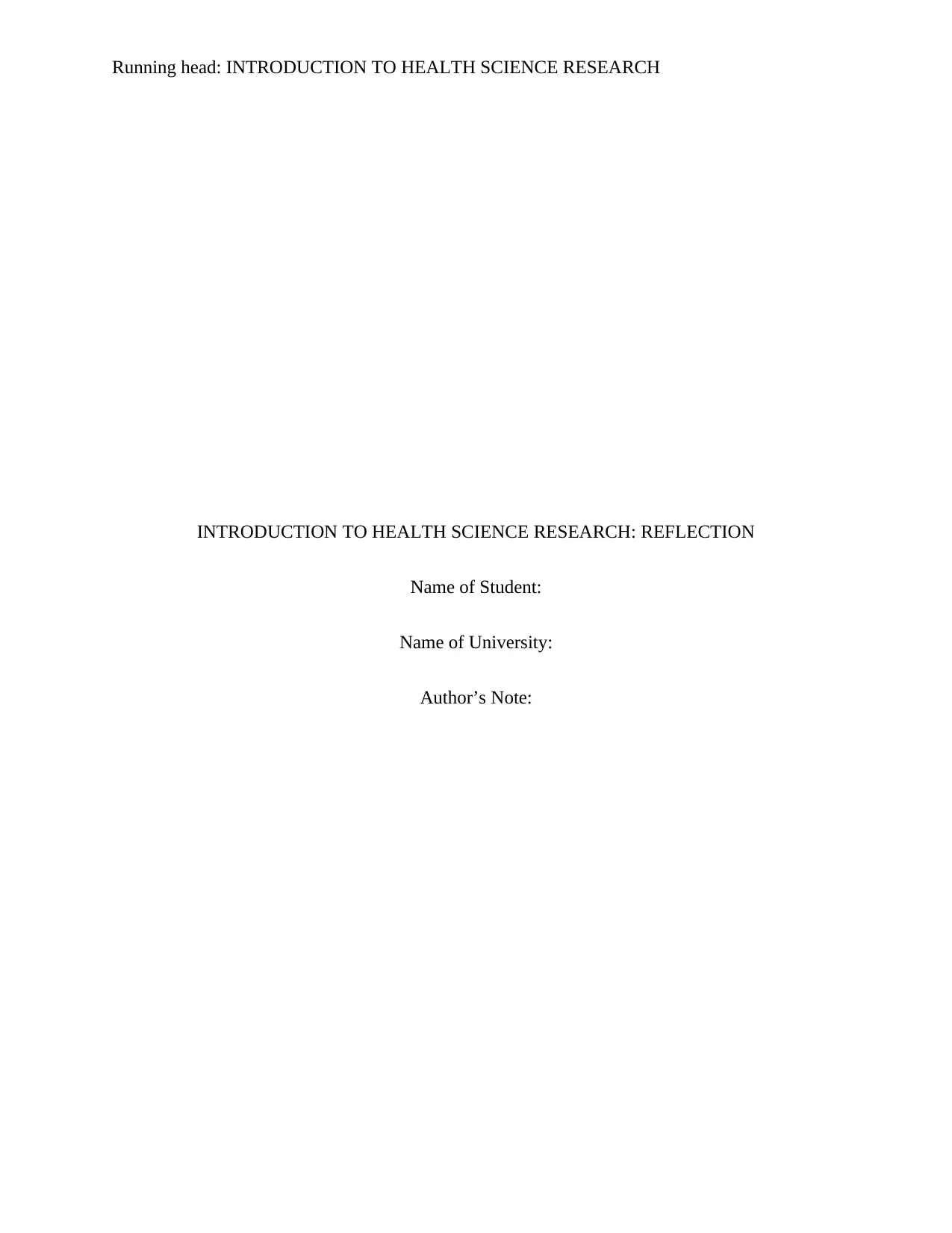
Running head: INTRODUCTION TO HEALTH SCIENCE RESEARCH
INTRODUCTION TO HEALTH SCIENCE RESEARCH: REFLECTION
Name of Student:
Name of University:
Author’s Note:
INTRODUCTION TO HEALTH SCIENCE RESEARCH: REFLECTION
Name of Student:
Name of University:
Author’s Note:
Paraphrase This Document
Need a fresh take? Get an instant paraphrase of this document with our AI Paraphraser
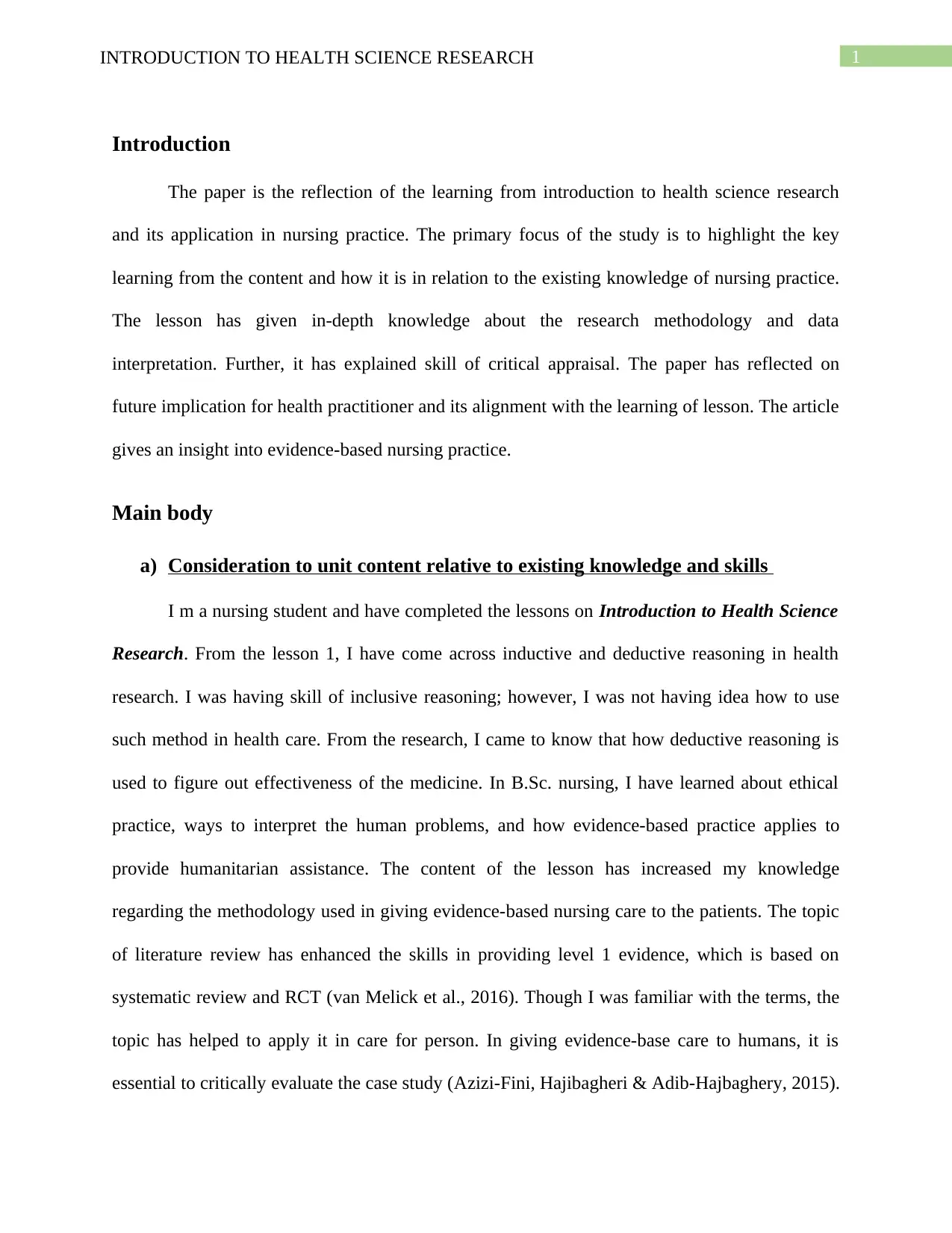
1INTRODUCTION TO HEALTH SCIENCE RESEARCH
Introduction
The paper is the reflection of the learning from introduction to health science research
and its application in nursing practice. The primary focus of the study is to highlight the key
learning from the content and how it is in relation to the existing knowledge of nursing practice.
The lesson has given in-depth knowledge about the research methodology and data
interpretation. Further, it has explained skill of critical appraisal. The paper has reflected on
future implication for health practitioner and its alignment with the learning of lesson. The article
gives an insight into evidence-based nursing practice.
Main body
a) Consideration to unit content relative to existing knowledge and skills
I m a nursing student and have completed the lessons on Introduction to Health Science
Research. From the lesson 1, I have come across inductive and deductive reasoning in health
research. I was having skill of inclusive reasoning; however, I was not having idea how to use
such method in health care. From the research, I came to know that how deductive reasoning is
used to figure out effectiveness of the medicine. In B.Sc. nursing, I have learned about ethical
practice, ways to interpret the human problems, and how evidence-based practice applies to
provide humanitarian assistance. The content of the lesson has increased my knowledge
regarding the methodology used in giving evidence-based nursing care to the patients. The topic
of literature review has enhanced the skills in providing level 1 evidence, which is based on
systematic review and RCT (van Melick et al., 2016). Though I was familiar with the terms, the
topic has helped to apply it in care for person. In giving evidence-base care to humans, it is
essential to critically evaluate the case study (Azizi-Fini, Hajibagheri & Adib-Hajbaghery, 2015).
Introduction
The paper is the reflection of the learning from introduction to health science research
and its application in nursing practice. The primary focus of the study is to highlight the key
learning from the content and how it is in relation to the existing knowledge of nursing practice.
The lesson has given in-depth knowledge about the research methodology and data
interpretation. Further, it has explained skill of critical appraisal. The paper has reflected on
future implication for health practitioner and its alignment with the learning of lesson. The article
gives an insight into evidence-based nursing practice.
Main body
a) Consideration to unit content relative to existing knowledge and skills
I m a nursing student and have completed the lessons on Introduction to Health Science
Research. From the lesson 1, I have come across inductive and deductive reasoning in health
research. I was having skill of inclusive reasoning; however, I was not having idea how to use
such method in health care. From the research, I came to know that how deductive reasoning is
used to figure out effectiveness of the medicine. In B.Sc. nursing, I have learned about ethical
practice, ways to interpret the human problems, and how evidence-based practice applies to
provide humanitarian assistance. The content of the lesson has increased my knowledge
regarding the methodology used in giving evidence-based nursing care to the patients. The topic
of literature review has enhanced the skills in providing level 1 evidence, which is based on
systematic review and RCT (van Melick et al., 2016). Though I was familiar with the terms, the
topic has helped to apply it in care for person. In giving evidence-base care to humans, it is
essential to critically evaluate the case study (Azizi-Fini, Hajibagheri & Adib-Hajbaghery, 2015).
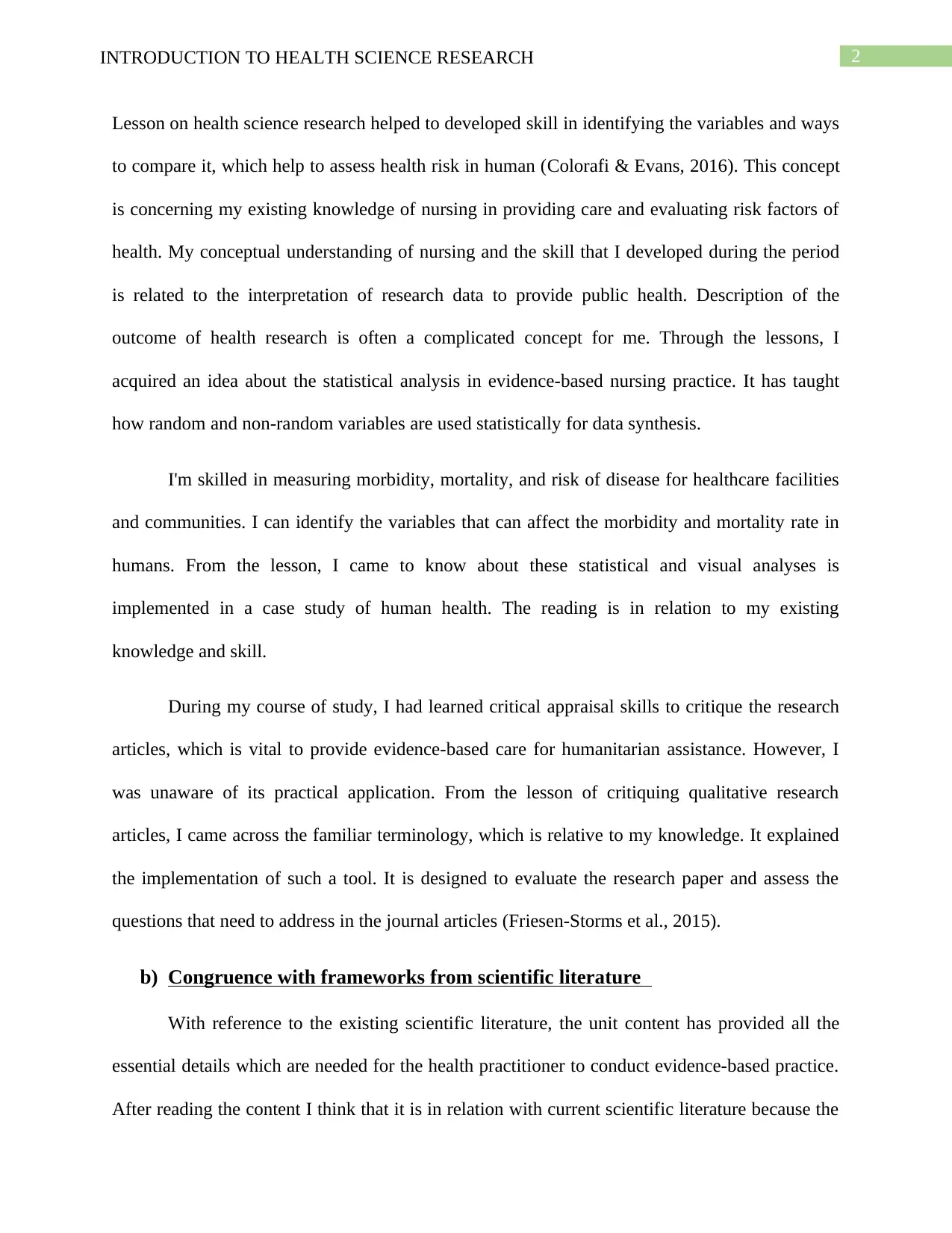
2INTRODUCTION TO HEALTH SCIENCE RESEARCH
Lesson on health science research helped to developed skill in identifying the variables and ways
to compare it, which help to assess health risk in human (Colorafi & Evans, 2016). This concept
is concerning my existing knowledge of nursing in providing care and evaluating risk factors of
health. My conceptual understanding of nursing and the skill that I developed during the period
is related to the interpretation of research data to provide public health. Description of the
outcome of health research is often a complicated concept for me. Through the lessons, I
acquired an idea about the statistical analysis in evidence-based nursing practice. It has taught
how random and non-random variables are used statistically for data synthesis.
I'm skilled in measuring morbidity, mortality, and risk of disease for healthcare facilities
and communities. I can identify the variables that can affect the morbidity and mortality rate in
humans. From the lesson, I came to know about these statistical and visual analyses is
implemented in a case study of human health. The reading is in relation to my existing
knowledge and skill.
During my course of study, I had learned critical appraisal skills to critique the research
articles, which is vital to provide evidence-based care for humanitarian assistance. However, I
was unaware of its practical application. From the lesson of critiquing qualitative research
articles, I came across the familiar terminology, which is relative to my knowledge. It explained
the implementation of such a tool. It is designed to evaluate the research paper and assess the
questions that need to address in the journal articles (Friesen‐Storms et al., 2015).
b) Congruence with frameworks from scientific literature
With reference to the existing scientific literature, the unit content has provided all the
essential details which are needed for the health practitioner to conduct evidence-based practice.
After reading the content I think that it is in relation with current scientific literature because the
Lesson on health science research helped to developed skill in identifying the variables and ways
to compare it, which help to assess health risk in human (Colorafi & Evans, 2016). This concept
is concerning my existing knowledge of nursing in providing care and evaluating risk factors of
health. My conceptual understanding of nursing and the skill that I developed during the period
is related to the interpretation of research data to provide public health. Description of the
outcome of health research is often a complicated concept for me. Through the lessons, I
acquired an idea about the statistical analysis in evidence-based nursing practice. It has taught
how random and non-random variables are used statistically for data synthesis.
I'm skilled in measuring morbidity, mortality, and risk of disease for healthcare facilities
and communities. I can identify the variables that can affect the morbidity and mortality rate in
humans. From the lesson, I came to know about these statistical and visual analyses is
implemented in a case study of human health. The reading is in relation to my existing
knowledge and skill.
During my course of study, I had learned critical appraisal skills to critique the research
articles, which is vital to provide evidence-based care for humanitarian assistance. However, I
was unaware of its practical application. From the lesson of critiquing qualitative research
articles, I came across the familiar terminology, which is relative to my knowledge. It explained
the implementation of such a tool. It is designed to evaluate the research paper and assess the
questions that need to address in the journal articles (Friesen‐Storms et al., 2015).
b) Congruence with frameworks from scientific literature
With reference to the existing scientific literature, the unit content has provided all the
essential details which are needed for the health practitioner to conduct evidence-based practice.
After reading the content I think that it is in relation with current scientific literature because the
⊘ This is a preview!⊘
Do you want full access?
Subscribe today to unlock all pages.

Trusted by 1+ million students worldwide
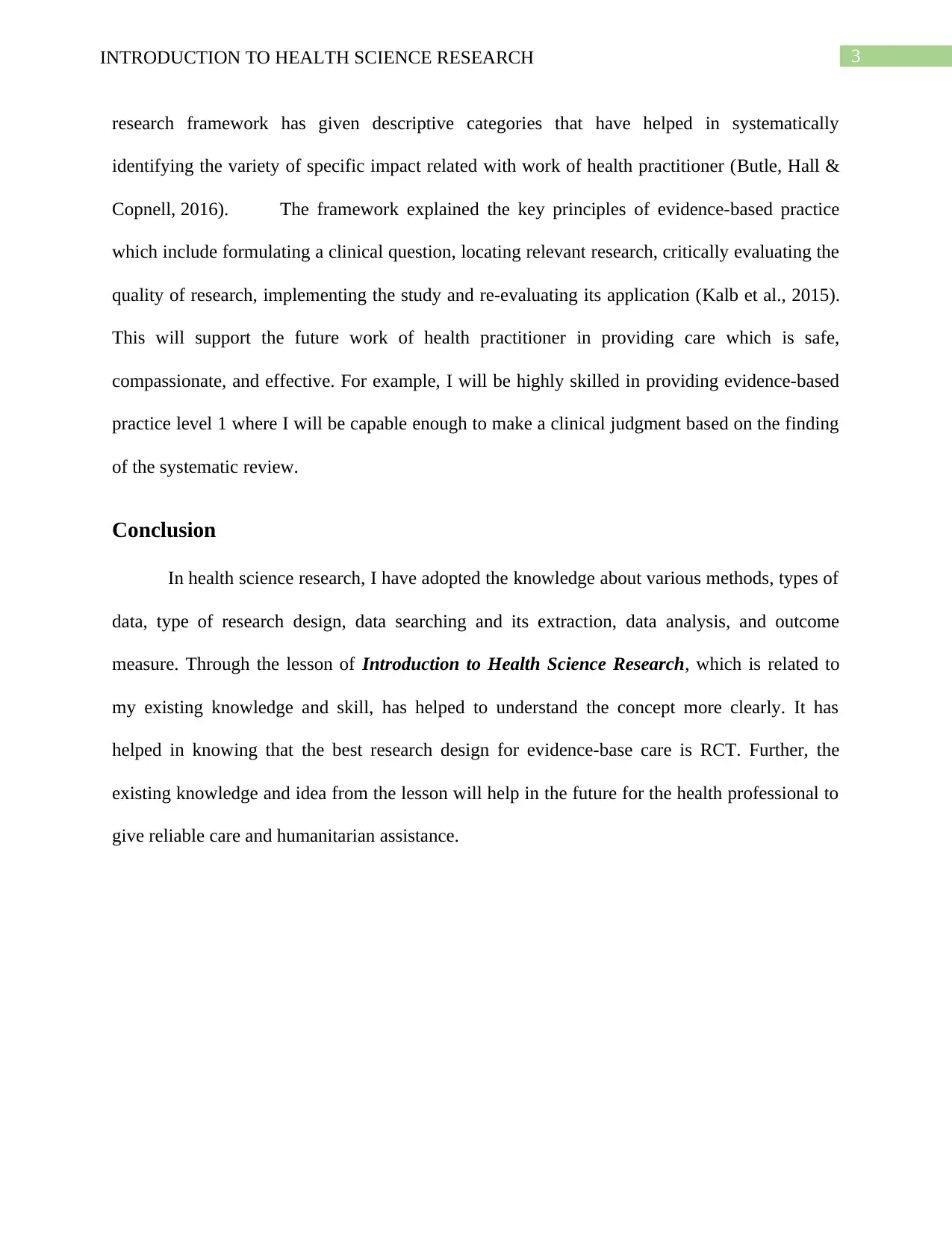
3INTRODUCTION TO HEALTH SCIENCE RESEARCH
research framework has given descriptive categories that have helped in systematically
identifying the variety of specific impact related with work of health practitioner (Butle, Hall &
Copnell, 2016). The framework explained the key principles of evidence-based practice
which include formulating a clinical question, locating relevant research, critically evaluating the
quality of research, implementing the study and re-evaluating its application (Kalb et al., 2015).
This will support the future work of health practitioner in providing care which is safe,
compassionate, and effective. For example, I will be highly skilled in providing evidence-based
practice level 1 where I will be capable enough to make a clinical judgment based on the finding
of the systematic review.
Conclusion
In health science research, I have adopted the knowledge about various methods, types of
data, type of research design, data searching and its extraction, data analysis, and outcome
measure. Through the lesson of Introduction to Health Science Research, which is related to
my existing knowledge and skill, has helped to understand the concept more clearly. It has
helped in knowing that the best research design for evidence-base care is RCT. Further, the
existing knowledge and idea from the lesson will help in the future for the health professional to
give reliable care and humanitarian assistance.
research framework has given descriptive categories that have helped in systematically
identifying the variety of specific impact related with work of health practitioner (Butle, Hall &
Copnell, 2016). The framework explained the key principles of evidence-based practice
which include formulating a clinical question, locating relevant research, critically evaluating the
quality of research, implementing the study and re-evaluating its application (Kalb et al., 2015).
This will support the future work of health practitioner in providing care which is safe,
compassionate, and effective. For example, I will be highly skilled in providing evidence-based
practice level 1 where I will be capable enough to make a clinical judgment based on the finding
of the systematic review.
Conclusion
In health science research, I have adopted the knowledge about various methods, types of
data, type of research design, data searching and its extraction, data analysis, and outcome
measure. Through the lesson of Introduction to Health Science Research, which is related to
my existing knowledge and skill, has helped to understand the concept more clearly. It has
helped in knowing that the best research design for evidence-base care is RCT. Further, the
existing knowledge and idea from the lesson will help in the future for the health professional to
give reliable care and humanitarian assistance.
Paraphrase This Document
Need a fresh take? Get an instant paraphrase of this document with our AI Paraphraser
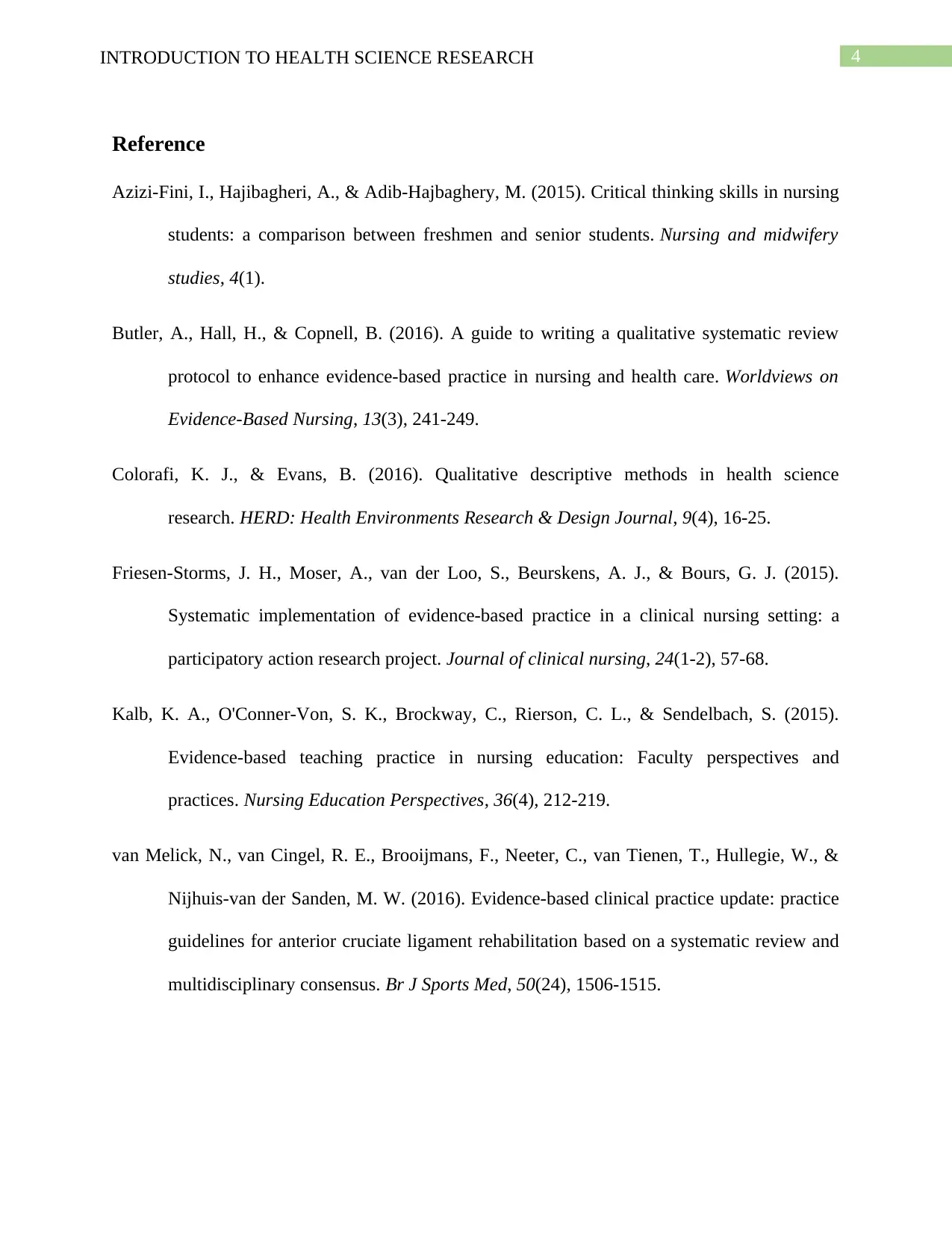
4INTRODUCTION TO HEALTH SCIENCE RESEARCH
Reference
Azizi-Fini, I., Hajibagheri, A., & Adib-Hajbaghery, M. (2015). Critical thinking skills in nursing
students: a comparison between freshmen and senior students. Nursing and midwifery
studies, 4(1).
Butler, A., Hall, H., & Copnell, B. (2016). A guide to writing a qualitative systematic review
protocol to enhance evidence‐based practice in nursing and health care. Worldviews on
Evidence‐Based Nursing, 13(3), 241-249.
Colorafi, K. J., & Evans, B. (2016). Qualitative descriptive methods in health science
research. HERD: Health Environments Research & Design Journal, 9(4), 16-25.
Friesen‐Storms, J. H., Moser, A., van der Loo, S., Beurskens, A. J., & Bours, G. J. (2015).
Systematic implementation of evidence‐based practice in a clinical nursing setting: a
participatory action research project. Journal of clinical nursing, 24(1-2), 57-68.
Kalb, K. A., O'Conner-Von, S. K., Brockway, C., Rierson, C. L., & Sendelbach, S. (2015).
Evidence-based teaching practice in nursing education: Faculty perspectives and
practices. Nursing Education Perspectives, 36(4), 212-219.
van Melick, N., van Cingel, R. E., Brooijmans, F., Neeter, C., van Tienen, T., Hullegie, W., &
Nijhuis-van der Sanden, M. W. (2016). Evidence-based clinical practice update: practice
guidelines for anterior cruciate ligament rehabilitation based on a systematic review and
multidisciplinary consensus. Br J Sports Med, 50(24), 1506-1515.
Reference
Azizi-Fini, I., Hajibagheri, A., & Adib-Hajbaghery, M. (2015). Critical thinking skills in nursing
students: a comparison between freshmen and senior students. Nursing and midwifery
studies, 4(1).
Butler, A., Hall, H., & Copnell, B. (2016). A guide to writing a qualitative systematic review
protocol to enhance evidence‐based practice in nursing and health care. Worldviews on
Evidence‐Based Nursing, 13(3), 241-249.
Colorafi, K. J., & Evans, B. (2016). Qualitative descriptive methods in health science
research. HERD: Health Environments Research & Design Journal, 9(4), 16-25.
Friesen‐Storms, J. H., Moser, A., van der Loo, S., Beurskens, A. J., & Bours, G. J. (2015).
Systematic implementation of evidence‐based practice in a clinical nursing setting: a
participatory action research project. Journal of clinical nursing, 24(1-2), 57-68.
Kalb, K. A., O'Conner-Von, S. K., Brockway, C., Rierson, C. L., & Sendelbach, S. (2015).
Evidence-based teaching practice in nursing education: Faculty perspectives and
practices. Nursing Education Perspectives, 36(4), 212-219.
van Melick, N., van Cingel, R. E., Brooijmans, F., Neeter, C., van Tienen, T., Hullegie, W., &
Nijhuis-van der Sanden, M. W. (2016). Evidence-based clinical practice update: practice
guidelines for anterior cruciate ligament rehabilitation based on a systematic review and
multidisciplinary consensus. Br J Sports Med, 50(24), 1506-1515.
1 out of 5
Related Documents
Your All-in-One AI-Powered Toolkit for Academic Success.
+13062052269
info@desklib.com
Available 24*7 on WhatsApp / Email
![[object Object]](/_next/static/media/star-bottom.7253800d.svg)
Unlock your academic potential
Copyright © 2020–2025 A2Z Services. All Rights Reserved. Developed and managed by ZUCOL.





